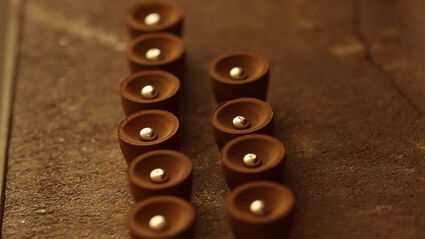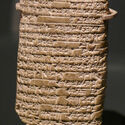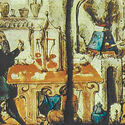An essay on 5,000 years of fire assaying
As one of Man's oldest analytical tools, fire assay has persisted through the centuries, providing a light in the dark for mining North of 60 Mining News – December 2, 2022
Last updated 12/1/2022 at 12:15pm

Precious Metals Assay and Training Institute
After a core sample has been burned away, what is left is a bead of doré, or a semi-pure alloy of gold and silver, that weighed and averaged to determine richness of the sample.
The magnitude of metals' role in humanity is made evident through the names of its ages – Stone, Bronze, and Iron – before the loftier eras that sought more esoteric meaning to life than mere survival. Yet, somewhat contrary to the ages of reason and learning, metal was still prevalent in maintaining the status quo for Mankind, and in perhaps the greatest of ironies, the method to test, extract, and refine metal came from the most primitive of gifts from the time earliest man took its first upright steps – fire.
Through the use of fire, man developed a time-tested method by which alchemists, wizards, and sages, and eventually chemists, metallurgists, and geologists, extracted mystical metals whose origins and properties belonged solely to the realms of gods.
This process is known as fire assay.
Fire assaying is an ancient and time-honored science, and even a kind of art form, that determines the precious metal content in ores, metallics, solutions, and all other materials bearing gold and silver.
Simply put, samples are crushed, mixed with fluxing agents, heated in a furnace until the metals become molten and separate, with the final target commodity being weighed.
These steps fall into the categories of scorification or cupellation, the former being the process that gathers metals into a workable form and the latter a technique by which non-precious or base metals are oxidized away, leaving the precious metals behind.
The fire assay method, still widely viewed as the most accurate means of determining gold and silver content, has been altered very little over the centuries.
Biblical proportions
Modern etymology suggests the word assay comes from 13th-century Anglo-French assaier, "to try, endeavor, strive; test the quality of," deriving from Old French assai, or a variant of essai meaning "trial."
While later attribution comes from the mid-14th century Anglo-French assai, which changed more subtly to "trial, test of quality, test of character," which ultimately derives from Late Latin exagium meaning "a weighing."
And finally, "trial of purity of a metal" from a late 14th-century derivation.
However, these definitions originate from late on the timeline as far as fire assaying is concerned, which begs the question, what was it called during its first mentioning?
While this question is a fun ponderable, the fact of the matter is, despite being called assay now, expressions of fire assaying can be found in literal and figurative references traced back to the time of Moses and can be found in numerous biblical references.
"Gold, silver, bronze, iron, tin, lead and anything else that can withstand fire must be put through the fire, and then it will be clean. But it must also be purified with the water of cleansing. And whatever cannot withstand fire must be put through that water." –Numbers 31:22-23; New International Version Bible.
With more metaphorical examples using terminology that would suggest a nuanced understanding of the process of refining metals.
"I have made you an assayer and a tester among My people, That you may know and assay their way. All of them are stubbornly rebellious, Going about as a talebearer. They are bronze and iron; They, all of them, are corrupt. The bellows blow fiercely, The lead is consumed by the fire; In vain the refining goes on, But the wicked are not separated. They call them rejected silver, Because the Lord has rejected them." –Jeremiah 6:27-32; New American Standard Bible.
Yet, the first indications of fire assay predate even Moses, with the origins of fire assaying usage being traced to findings in Troy (roughly 2600 B.C.), the Cappadocian Cuneiform Tablets (2250-1950 B.C.), as well as the Amarna letters (1350 B.C.).
With accounts from over 5,000 years ago, historians were able to determine that pure silver was made as early as the 25th century B.C.
Furthermore, from this evidence, it was concluded that the cupellation process and therefore fire assaying, was invented in Asia Minor in the first half of the third millennium B.C., shortly after the discovery of the manufacture of lead from galena.
Historian Theodore Wertime even wrote in 1973 that the first convincing evidence of the production of silver from lead ores is from the cupel buttons found at Mahmatlar in the late third millennium B.C. that now reside in the Hittite Museum in Ankara, Turkey.
Nevertheless, "modern" assaying began to appear in literature in the 12th century in France and England, which our present word could possibly be attributed to, and thus spread over time to the rest of Europe.
Renaissance revival
It is said that the Romans were able to desilver lead down to 0.01% or even 0.02% in some cases, with one roman lead pipe sample being found to be desilvered almost completely.
After the fall of the Roman Empire, however, intellectual life stagnated for nearly 500 years. With the revival of learning in the later centuries of the Middle Ages, the art of assaying was renewed vigorously.
One man stood above the rest during this period, Georgius Agricola.
In 1529 he began to write "De Re Metallica," which he completed in 1550 but would not send to publishers until 1553. In his book, Agricola was the first author to attempt to cover the subject of fire assaying in its entirety and arranged his material systematically.
He described the tools and equipment to be used in assaying, stressed the quantitative aspects of each step, and for the first time, gave instructions for assaying.
The significance of De Re Metallica could not be overstated as it became the foremost textbook on fire assaying and served as a guide to miners and metallurgists for nearly 200 years.
One passage from Metallica states an almost overzealous approach to the practice of assaying.
"It is necessary that the assayer who is testing ore or metals should be prepared and instructed in all things necessary in assaying, and that he should close the doors of his room in which the assay furnace stands, lest anyone coming in at an inopportune moment might disturb his thoughts when they are intent on work."
While somewhat extreme for this day and age, this nevertheless points out the degree of diligence that is still put into the work of assaying mining results.
Although several publications on fire assaying and metallurgy would appear throughout the 16th and 17th centuries, it would not be until the first half of the 18th that creditable works – such as C. A. Schlute's "Hutte-Werken, Braunshweig," published in 1738, and cited by the eventual U.S. President Hoover and his wife in their translation of Agricola – began to eventually supersede Metallica.
Numerous publications on fire assaying, mining, and metallurgy would then follow into the 19th and 20th centuries, and as the age of digitalization and the growing fascination with noble metals, the process of firing rock to find metal will continue to be a mainstay for many more years to come.
USGS fire assaying
It was in 1879 when the first director of the newly-formed U.S. Geological Survey, Clarence King, instructed geologist-in-charge Samuel Emmons to undertake a detailed study of the geology and mining industry in Leadville, Colorado.
The next year, Emmons was fortunate in securing the services of Antony Guyard, a former pupil of the L'École des Mines d'Alès – a French technology and engineering university founded by King Louis Phillipe in 1843 – who, for 12 years, was a chemist at the well-known metallurgical works of Johson & Matthey, one of England's oldest gold assayers (now known as Johnson Matthey and still exist to this day).
Thus, in Denver, in 1880, Emmons and Guyard were the first in the USGS to use fire assay as an analytical technique.
Emmons and Guyard, along with the later addition of W. F. Hillebrand, started a chemical laboratory in the Mile High City, essentially establishing the first assay lab until the death of Guyard in 1884. As a result, Hillebrand moved to Washington, D.C., and by 1888, the USGS's first lab shuttered its operations.
Although Hillebrand's major interest lay elsewhere, he had become sufficiently familiar with fire assaying and had the equipment necessary to investigate the steps needed for fire assaying of gold telluride ores.
Partnering with a Mr. E. T. Allen (Hillebrand and Allen, 1905), the results of these investigations remain the basic study for gold telluride analysis to this day. Their experiments, though extensive, suggested the need for additional work. However, the Washington quarters occupied by the USGS had become so crowded that the assay furnaces were summarily dismantled, and assaying was abandoned altogether.
It would remain this way for nearly 50 years when in 1948, there was a need to determine the gold and silver content of samples collected for uranium and thorium investigations, particularly around the Front Range of Colorado.
With both the volume of this work and the security requirements of that time making it imperative for the USGS to do its own fire assaying, a man named D. L. Skinner, who had once worked at the chemical laboratory in Denver and had extensive fire assaying experience at the U.S. Mint, would supervise the purchase and installation of equipment.
Thus, in 1951, making it an exact 50 years, fire assay was revived in the USGS, with the furnace being christened by baking a pan of biscuits before it became contaminated by lead.
Later down the line, in 1966, investigations for the heavy-metals programs – particularly those concerned with gold and other noble metals – encouraged the expansion of analytical techniques and a search for new ones.
While ultimately the introduction of atomic absorption, optical emission spectrography, and neutron-activation analysis helped to improve the very oldest analytical method known by man, by combining it with modern techniques, the baseline has never shifted from burning or melting away the undesired for the sought gold or silver – until now.
PhotonAssay
Hindsight would predicate that through the discovery of X-ray or electron microscopy, advances in scanning technologies in mineralogical settings would have made a much more significant leap forward than continuing to use the tried-and-true method of fire assay.
However, it wasn't until very recently that a new technology encouraged a complete paradigm shift in analytical processes for the mining industry – in fact, its infancy still has yet to truly take off from traditional practices.
While the X-ray machine would be accidentally discovered in 1895 and the electron microscope in 1931, it has been over 120 years since the former and nearly 100 for the latter in any other kind of advanced scanning technology.
Most people traveling experience ionizing radiation scanning equipment at airports to scan their passengers and luggage before boarding, which is arguably still more timely than fire assay.
Described as a relatively simple process, the truth is fire assaying takes time, and with limited labs conducting analysis work for dozens of mining, geological, metallurgical, and any other kind of earth analyses, it is downright slow.
A product of Australia's Commonwealth Scientific and Industrial Research Organisation (CSIRO), PhotonAssay works on the same basic premise as a handheld XRF (X-ray fluorescence) analyzer, which has already become indispensable in mineral exploration.
Samples fed into a PhotonAssay unit are bombarded with high-energy X-rays that excite the atomic nuclei of the contained gold; signature gamma rays are emitted by the excited aurum, which is then measured, providing an extremely fast and highly accurate analysis of the gold contained in a sample.
Instead of prepping a sample with fluxes and other additives to prepare for the furnace, crushed samples to be analyzed by PhotonAssay are simply put into uniquely identified containers that are weighed and then placed on a conveyor belt to be fed through the analysis machine.
With an accurate measurement of the contained gold in as little as two minutes, a single PhotonAssay unit can process up to 1,400 samples per day, with only a single operator needed to place the samples on the input conveyor and then to remove the analyzed samples from the other side.
Compared to a 10- to 50- gram sample size for fire assay that can take weeks to analyze, PhotonAssay units can analyze sample sizes ranging from 250 to 650 grams in minutes.
With much larger sample sizes, it provides a more accurate analysis of high-grade gold systems where assay results can be skewed by the nugget effect – depending on whether an outsized lump of gold was either included or excluded from a sample.
In addition to its speed and accuracy, due to the nature of fire, samples are destroyed using the conventional method, whereas, with PhotonAssay, samples can be retained for reevaluation later down the line if needed.
But that's just the icing on the cake; while fire assay has predominantly been used to test for silver and gold, PhotonAssay can also be tuned to detect copper and other complementary elements.
With the extent of fire assay and how it has influenced human innovation and development, even so far as to incur several mentions in the bible, it can be easily surmised the significance of a new technology to scan for metal will be for the coming generations.
With efforts to reach for the stars, essentially for the sake of more mineral exploration, there may come a day, perhaps 5,000 years from now, when a USS Enterprise scans a foreign planet and, due to the technology developed today, can get an accurate reading of the makeup of the planet in seconds.














Reader Comments(0)